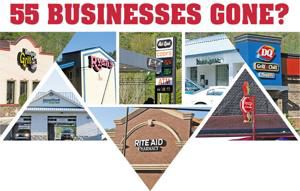Originally published in The Sylva Herald by Quintin Ellison

by The Sylva Herald
As many as 55 business owners along N.C. 107 and U.S. Business 23 could see their workplaces condemned and destroyed as part of a planned remodel of Sylva’s bustling commercial corridor.
The N.C. Department of Transportation plans to begin right-of-way acquisition in December and start construction in 2020. The project is expected to take two years to complete.
It’s early yet – the number of affected properties could change as the NCDOT moves from crafting preliminary designs to approving a finished product.
“We are committed to continuing to work with our stakeholders in developing this project. We are still at a position that the plans could be modified,” Division Engineer Brian Burch, who oversees Division 14, said Monday.
As it stands now, possible roadwork casualties include Speedy’s Pizza; Sheds Hunting Supply; Mesquite Grill; Jackson County Veterinary Associates; O’Malley’s Pub & Grill; Cody’s Hotspot Gas & Convenience Store; Wendy’s; and Ryan’s Steakhouse. (For a complete listing of the businesses, click on the PDF map on the left-hand side of this page, titled “Construction could impact dozens of businesses, or click here.)
“There is a chance that the number of relocations can be reduced,” Project Engineer Jonathan Woodard said. “We have instructed our design firm to explore opportunities to do so.”
NCDOT’s plans call for eliminating the so-called “suicide lane,” with a 17.5-foot grass median separating the two lanes of southbound traffic from two lanes of northbound traffic on N.C. 107. Sidewalks would be replaced and a 5-foot bike lane added.
Upgrades are slated, too, for N.C. 107/U.S. 23 Business intersection and U.S. 23 Business to Dillardtown Road and Municipal Drive at the Sylva Fire Department.
NCDOT’s goals are twofold: ease gridlock and make the roads safer for motorists.
More than 32,400 vehicles per day use this heavily trafficked stretch of N.C. 107. That number is expected to increase to 39,200 vehicles per day by 2035.
‘Major impact’
It’s not easy just to move.
Those business owners in Sylva’s commercial corridor forced to find new homes would find the process challenging, transportation officials say in newly released public documents.
“It should be noted that this project will have a major impact on the businesses in this section of Sylva,” NCDOT’s relocation report states. “The impacted businesses will have a difficult time locating available sites suitable for business purposes. Suitable business sites in and around Sylva are very limited.”
Additionally, three homeowners and two tenants could be displaced, according to the relocation report.
State law requires NCDOT treat property owners impartially. The agency must explain legal rights, pay just compensation and provide relocation assistance.
Using the state’s legal powers of eminent domain, NCDOT goes through the courts if a settlement cannot be reached with a property owner.
In addition to condemnation reimbursement and moving-expenses help, business owners can receive compensation of up to $25,000 in reestablishment payments. This money is earmarked for carpentry, paving, electrical and marketing.
Questions abound
The placement of utilities, such as power and phone lines, communications fiber and water-and-sewer pipes, as well as storm-drainage design, are among the reasons a definite list of affected business remains a moving target.
“(The) information is not yet available, so we don’t know what those impacts will be,” NCDOT Engineer Woodard said.
Transportation officials have discussed housing utilities in bundled PVC conduits, cased in concrete and metal, in an underground duct bank.
Woodard said the agency doesn’t know yet whether it’s feasible, or if burying them would help to reduce the project footprint.
“Even underground, the equipment takes a lot of space,” he said. “Provisions for access to maintain the facilities and to expand service in the future must be considered.”
Cost
The dollar amount for right-of-way acquisition is higher than transportation officials expected. A lot higher.
NCDOT preliminarily estimated it would cost taxpayers $33.3 million to remake the N.C. 107 commercial corridor: $18.6 million for construction and $14.7 million for right of way.
The latest right-of-way estimate totals $47,571,500.
NCDOT’s Right of Way Unit derived the amount based on 25-percent design completion, according to Division Engineer Burch.
“The right-of-way costs are much greater than what had been originally estimated,” he said.
“When projects are identified, NCDOT has been using statewide averages for certain facility types. In the mountains, our costs for construction are generally much higher than the statewide averages.”
NCDOT used an average to estimate costs, an effort “to level the playing field” for projects across the state, Burch said.
“In this latest round of SPOT (a project prioritization system), we have reviewed the costs of our projects to provide a better estimate, so that we don’t have these increases.”


